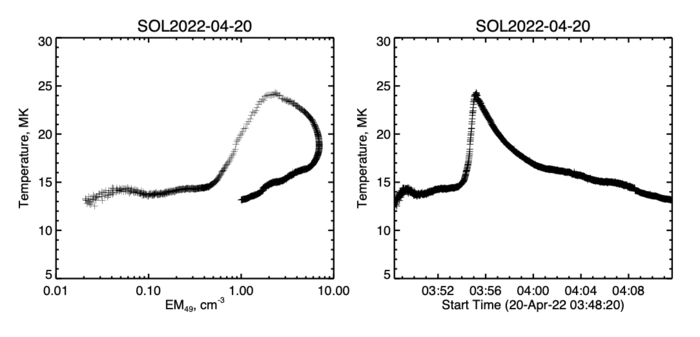A slow HOPE with microwave context
From RHESSI Wiki
(Add 441) |
|||
| Line 5: | Line 5: | ||
|first_author = Hugh HUDSON | |first_author = Hugh HUDSON | ||
|publish_date = December 13, 2022 | |publish_date = December 13, 2022 | ||
| - | |next_nugget = | + | |next_nugget = Magnetic precursor |
|previous_nugget = {{#ask: [[Category:Nugget]] [[RHESSI Nugget Index::440]]}} | |previous_nugget = {{#ask: [[Category:Nugget]] [[RHESSI Nugget Index::440]]}} | ||
}} | }} | ||
Latest revision as of 11:10, 14 February 2023
| Nugget | |
|---|---|
| Number: | 441 |
| 1st Author: | Hugh HUDSON |
| 2nd Author: | |
| Published: | December 13, 2022 |
| Next Nugget: | Magnetic precursor |
| Previous Nugget: | Rapid variations of Si IV spectra in a flare observed by IRIS at a sub-second cadence |
| List all | |
Contents |
Introduction
Our old friend the GOES soft X-ray monitoring recently revealed a surprising property of solar flares, and one not captured at all in any yet known cartoon. We introduced this in Nugget No. 421 some time ago. The novelty here has now gotten much firmer support: in a nutshell, flares almost invariably start at high temperatures, described in the previous Nugget as a "horizontal branch" in the [EM, T] correlation diagram following the time series of isothermal-fit parameters to the soft X-ray spectrum
This "hot onset" phase of a flare is its precursor, about which there is abundant literature (see for example Ref. [1]). This and many other papers discuss the physical conditions that lead to a flare or eruption, often relying on the wonderful EUV image data from AIA. The hot onset precursor event (HOPE) uniquely requires an unknown regulatory mechanism for the preflare plasma: its emission measure may grow by an order of magnitude, with very little detectable temperature variation. In particular there is no evidence for "preheating" in the sense of dT/dt > 0.
A recent slow HOPE event with novel data
A recent preprint (Ref. [2]) described a new microwave spectroscopy facility, the Chashan Broadband Solar (CBS) instrument, in the context of observations of SOL2022-04-20 (X2.2). This limb event turns out to have been an archetypical "slow HOPE" event, as the diagrams in Figure 1 show. Note especially the horizontal branch in the left panel.

The interesting interpretations of this event, as described in Ref. [2], are in the evolution of the gyrosynchrotron emission of the impulsive phase. Analysis of this event for its HOPE content -- aiming at understanding the temperature regulation -- remains to be done. Most interestingly, Ref. [2] notes context data that may help considerably in a future analysis.
For more explanation of the complexities of the main part of the diagnostic diagram, see the earlier Nugget.
Conclusion
Slow HOPE events allow us to study the hot onsets with a bit of liesure. Does the appearance of a temperature regulation result from a steady process, or is it the result of many similar events running together in a confused mannet? Certainly some flare precursor events, such as that reported from the Yohkoh era in Ref. [3], do seem to consist of discrete events. Others (such as this case) don't; either way the question is physically interesting and wide-open. In addition, we have a vast array of multi-wavelength and multi-messenger data now, as illustrated by the event described here. Somebody just has to analyze these data! For the original description of flare hot onsets (HOPEs) see Ref. 4].
References
[2] "The first flare observation with a new solar microwave spectrometer working in 35-40 GHz"
[3] "Soft X-Ray Pre-Flare Emission Studied in Yohkoh-SXT Images"
[4] "Hot X-ray onsets of solar flares"
| RHESSI Nugget Date | 13 December 2022 + |
| RHESSI Nugget First Author | Hugh HUDSON + |
| RHESSI Nugget Index | 441 + |